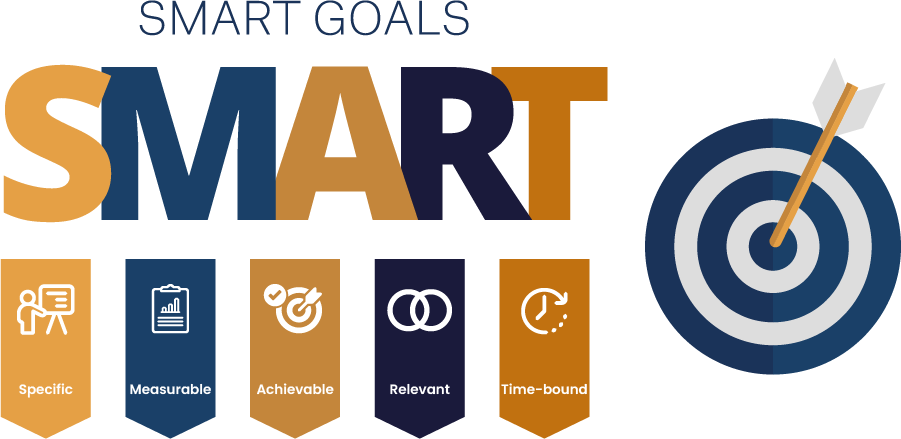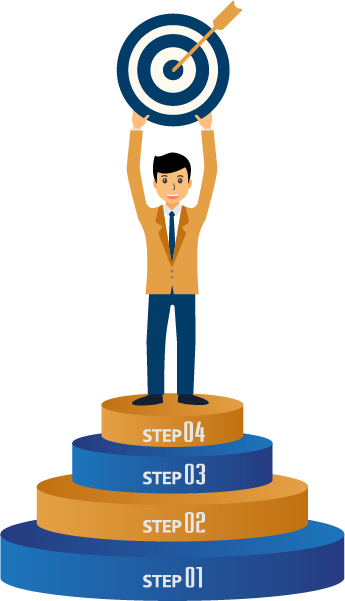Just like a journey needs a destination, our professional and personal lives need goals to provide direction.
Vague ideas won’t get us far. This is where SMART goals come in. They offer a structured framework to achieve what we truly desire.
We can integrate SMART objectives with Continuing Professional Development for even greater effectiveness. Together they make sure that your efforts are focused and that you are on the right path to achieve your desired results.
This blog post will help you understand what SMART goals are, their benefits, and how one can achieve them strategically yet successfully. But first, what does SMART stand for and where does it come from?
What does SMART Stand for?
The acronym SMART stands for:
- Specific
- Measurable
- Achievable
- Relevant
- Time-bound

Where do SMART Framework Come From?
Though the idea has been around for some time, the SMART acronym and the framework were devised and put forward by George T. DORAN in 1981. Since then, SMART goal-setting has been used by thousands of companies, organisations, and individuals.
How Can You Decide the Scope of Your SMART Goals?
SMART goals are meant for your day-to-day job responsibilities.
Remember, goals help you stay focused and motivated. Simultaneously, they demand focus and undivided attention to achieve them timely and successfully; and doing it through the SMART criteria is the ideal option.

A few examples of goals may look like this:
- I want to improve….
- I want to save….
- I want to increase….
- I want to make….
- I want to complete….
What Does SMART Goals mean in CPD?
SMART goals in CPD are similar to achieving a personal goal. Setting SMART objectives for this can be very helpful; for instance, you may want to work toward a promotion, improve your communication skills, or enhance your leadership skills as a manager.
Sometimes we feel like we are working hard at our jobs but haven’t actually achieved anything. A massive reason could be that you have not decided which particular goal you are working toward. Because of that, setting SMART objectives can be more beneficial.
How Can You Utilise SMART Objectives to Excel in Your Professional Development?
Using SMART objectives can help you excel and grow in your career or professional development. Regardless of your job position, you can improve, develop, increase, and control the outcomes at your work.
Also, by working through a detailed and structured action plan you can show that you are committed to achieving your goals and ambitions.
Suppose you join a company as a junior and wish to lead a team one day; utilise SMART criteria to gain necessary management and leadership skills and much more.
But before we explain how you can achieve your goal through SMART objectives, you must know the difference between goals and objectives.

Difference Between Goals and Objectives
In simple words, a goal is a long-term aim. For example, ‘wanting to become a manager at a company’.
On the other hand, an objective refers to specific and measurable steps taken to achieve that goal; like arranging meetings once a month with the supervisor to evaluate and determine your weak areas.
Considering this, we have written how you can set SMART objectives with an example of ‘improving your listening skills’ at your workplace below:
How to set SMART CPD objectives

Here is how can you set SMART objectives for improving listening skills as part of your professional development:
Specific
Before setting an objective, make sure it is specific so that you know exactly what you’re aiming at. You may ask questions like what do I need to accomplish? What steps need to be taken and who is going to be responsible for it?
So, in case of improving ‘listening skills’, your specific objective would be:
- Improving listening skills via active listening techniques to enhance listening during meetings and conversations.
- For example: Actively listen to the meeting agenda, and colleagues’ discussion and summarise meeting minutes.
Measurable
The second step is to measure your progress because it would be useless to not track your progress.
But how can you measure and determine you are making progress? Measurement method can be both qualitative or quantitative; but for the above-mentioned example:
- You can track your progress by receiving detailed feedback from your colleagues or completing a self-assessment form once a week.
- For example: Summarise meeting minutes and try to give concluding remarks.
You could also track the number of active listening techniques you incorporate in conversations
Achievable
Setting SMART objectives is good, but the real question is – can you achieve it realistically? Is it within your scope? Remember that you are meant to be motivated by your goal not discouraged; therefore, think about:
- How do you attain these objectives within your schedule and workload?
- For example: Incorporate active-learning cues in your daily life and respond during the meeting
So, what you can do is dedicate 15-20 minutes to practising active listening techniques such as paraphrasing or reflecting on what was said during a conversation with your clients or techniques.
Relevant
Relevancy of objectives focuses on something that aligns and makes sense with your goal, moving you in the direction of your dreams and ambitions.
- Consider paraphrasing the information to the clients for better understanding and reducing misunderstanding
In your case, having strong listening skills is important for professional development; they can improve communication and help you understand your colleagues better, meeting your CPD requirements of improved communication abilities.
Time-bound
Setting objectives is easy and anyone can set them, but can they be achieved in a specific timeframe? if one lacks realistic timing, chances are, they will fail. Therefore, a target date is important.
This step focuses on ‘when you want to achieve your objectives.’
- For instance, you can set 3 months to master at least 4 listening techniques for meetings; setting a clear deadline or planning a timeframe can help you achieve your objectives successfully.
- For example: Complete an online active learning course by a specified time and incorporate the learned skills into daily life.
So, your complete SMART goal would be:
Over the next three months, I will master 4 techniques and improve my active listening skills to enhance professional interactions and client communications.
I will do this by dedicating 15-20 minutes daily to practising paraphrasing, reflective listening techniques, and seeking feedback from colleagues after each meeting and completing weekly self-assessment forms.
This goal is achievable within my current workload and directly relevant to my CPD requirements, as it will improve my understanding of client needs and team collaboration.
What are the Benefits of SMART OBJECTIVES in CPD?
Continuing professional development is considered lifelong learning to maintain and enhance skills competence and understanding, SMART objectives are one of the powerful tools to make your CPD more effective.
Here is how:
- They clearly define what your specific goal is and what is it that you want to achieve in your professional development. It ensures that you are not running in circles but rather moving in the right direction of your goal, knowing exactly what you need to accomplish.
- It helps you track your progress, monitor your achievements and stay motivated, which contributes to your development. Not only that, but you can adjust your approach according to your needs and preferences to achieve your objectives.
- Additionally, SMART objectives also make sure your goals are attainable and realistic to achieve and keep you engaged in your CPD journey.
- Relevant objectives make sure that you keep your CPD activities aligned with your professional development goals.
- On top of that, time-bound objectives will provide a clear deadline to achieve your goals. In such a way, you will allocate your time and prioritise tasks accordingly.
Above all, SMART objectives provide a clear and structured framework for your continuing professional development and lead to more successful and efficient outcomes.
Conclusion
In conclusion, SMART goals are a powerful tool to help you achieve and elevate your CPD experience. By setting Specific, Measurable, Achievable, Relevant, and Time-bound goals, you ensure your professional development stays focused and effective.
SMART objectives provide clarity, direction, and motivation on your goal of achieving your career aspirations. They keep you accountable and on track, maximising the value of your CPD efforts.
So, be SMART, embrace these objectives and watch your professional development flourish.
























